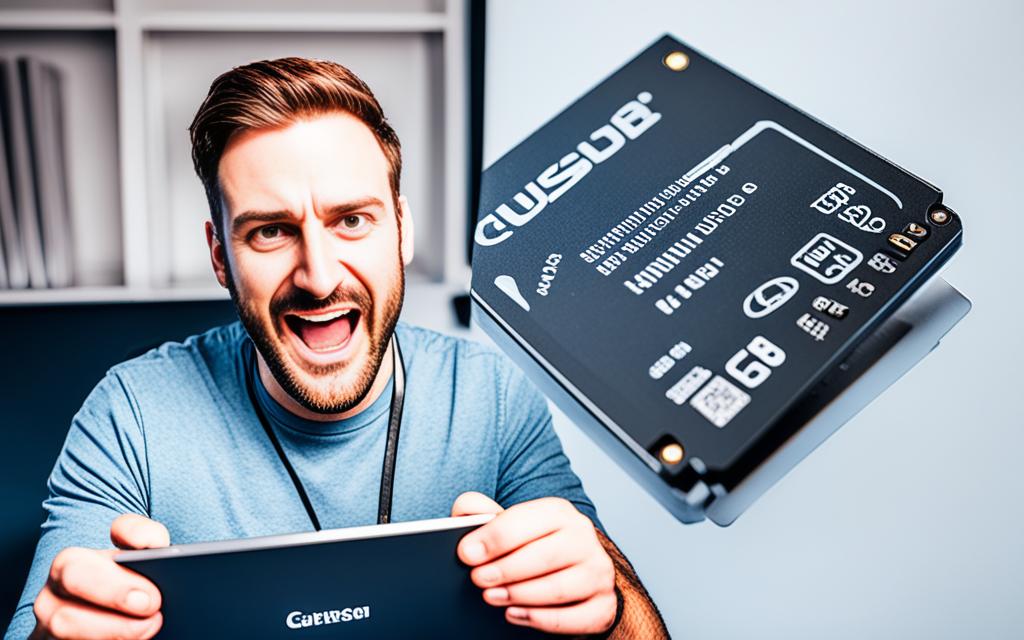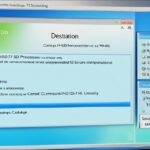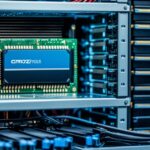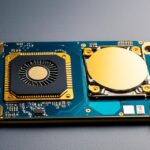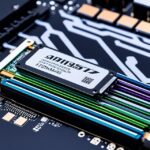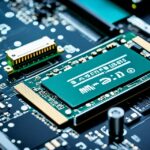Table of Contents
Upgrading your SSD is key for anyone keen on technology. It boosts your computer’s speed and overall performance. With technology constantly advancing, upgrading isn’t just nice to have; it’s necessary. Opting for data cloning means you don’t have to reinstall your operating system. This saves time and keeps all important files, apps, and settings safe. Cloning allows for an easy move to a new, speedy SSD. This is especially true for the latest M.2 NVMe SSDs which offer more space for your buck. Now is a great time to upgrade, as 1 TB SSDs are affordable and reliable, costing under $501.
Key Takeaways
- Upgrading your SSD enhances overall performance and efficiency.
- Data cloning ensures a seamless transition to your new drive.
- Modern SSD options provide significant storage at affordable prices.
- Choosing the right SSD is pivotal for achieving optimal performance.
- Understanding cloning software can simplify the upgrade process.
Understanding the Importance of Upgrading Your SSD
In today’s world, upgrading your SSD is crucial. With new tech, old hard drives can’t keep up. Upgrading boosts your computer’s speed, reliability, and efficiency. This is key for the best computer use.
Why Upgrading is Necessary
Nowadays, apps and operating systems need more from storage devices. Traditional hard drives slow down, causing delays. This happens during startup or when opening apps. SSDs start and load everything faster than HDDs2.
Also, SSDs get full, so getting a bigger one is a must for staying productive. They last longer and use less power than HDDs. This makes SSDs a smart choice for the long run3.
Benefits of a Larger SSD
Having more storage with a bigger SSD improves your computer’s speed. This means faster system responses and shorter wait times for apps. This is especially important for graphics or gaming enthusiasts4.
There are different sizes available, like 512GB and 1TB. You can choose the best one for your needs without losing speed or space3.
Looking to upgrade? Check out the installation guide. It shows how to switch without losing data. Using the right cloning software is key. This careful plan enhances your SSD’s benefits and makes the upgrade worthwhile.
Choosing the Right SSD for Your Needs
Choosing the perfect SSD can hugely impact how your computer works. It’s crucial to know about different SSDs to pick one that meets your needs.
Types of SSDs: SATA vs NVMe
SATA SSDs and NVMe SSDs are the main SSD types. SATA SSDs fit with lots of systems. They range from 120GB to 2TB. Prices begin at about $15 for an upgrade from 120GB to 250GB5. They work well for daily use but are slower than NVMe SSDs. NVMe SSDs can be five times faster. This is especially true with PCIe 4.0 tech, which doubles the speed5.
For those who need lots of storage, M.2 SSDs in thin laptops offer up to 8TB. They are excellent for professional settings5.
Factors to Consider When Purchasing an SSD
Deciding between SATA and NVMe involves several factors. The type of NAND flash is key. SLC is fast but pricey, while MLC and TLC offer a good mix of speed and cost. Also, DRAM makes SSDs faster, which is great for boot drives. A 500GB SSD is often seen as the best mix of cost, speed, and size. 1TB is also popular, especially if it’s under $1005.
For special needs, SSDs over 2TB are more expensive. Prices can exceed $400, fitting mainly for pros who need a lot of space5.
Looking at these factors can help you choose the right SSD. For how-tos on upgrading your SSD for better performance, check out this link.
How to Upgrade SSD Without Losing Data
Upgrading your SSD can feel overwhelming, especially when you want to keep your data safe. The key is to use the SSD cloning process. This creates an exact copy of your old drive on the new one.
This isn’t just about moving files. It involves a detailed approach to data transfer. This keeps your information fully intact.
Understanding the Cloning Process
The SSD cloning process is designed to protect your data. It doesn’t just copy files but creates an exact image of your drive. This way, all your apps and settings move over without loss. Opting for cloning means a smooth change to your new SSD. EaseUS Disk Copy is good for this. It works with Windows 11, 10, 8, and 7. It helps with moving to a bigger drive without reinstalling Windows6.
Software Options for Cloning
Many software options are out there for SSD cloning. People like Acronis True Image and Macrium Reflect. Half of users suggest Macrium Reflect because it’s easy and reliable7. Others prefer Clonezilla Live, but 20% find it hard, especially for beginners7. Some SSD makers offer their cloning software for free. These tools may let you resize partitions during cloning to meet your needs.
When starting with SSD cloning, make sure the new SSD is as big as the old one. This ensures a smooth transfer without losing data.
Using professional cloning software is key to keeping your data safe. With the right tools and knowledge, you can boost your computer’s performance. You’ll get a faster and better user experience.
To learn how to move your data successfully, look at this useful guide.
Step-by-Step Guide to Cloning Your SSD
Following a structured approach to SSD cloning can make the process smoother. In this guide, we will cover the key steps of cloning. This includes preparation, the cloning process itself, and what to do after cloning.
Preparation Before Cloning
First, start by backing up all important data. Cloning is reliable but it’s best to be prepared for any issues. Make sure your new SSD is compatible and properly installed. It should be connected to your motherboard via SATA or M.2 ports.
Your new SSD’s capacity must be larger than the data on your old HDD. For instance, if you’ve used 151.79 GB on your HDD, get an SSD that’s at least 152 GB. This ensures everything fits nicely8.
Executing the Cloning Process
Choosing the right software is key when you start cloning. Carefully pick the source and destination drives and follow the directions given by the software. Many cloning tools, like EaseUS Disk Copy, can adjust partition settings automatically. But, you might need to make manual adjustments for specific needs.
Cloning a 1TB drive normally takes about 17 minutes8. For Steam Deck users, cloning is easier with Steam OS 3.2+. It can automatically adjust partitions if there’s extra space on the disk9.
Post-Cloning Steps to Ensure Success
After cloning, it’s vital to check the data on your new SSD. Ensure all files are present and working. If using a Steam Deck, it will adjust the home partition and filesystem for you, making things smoother9.
Don’t forget to update your backup procedures and recovery options. This guarantees a hassle-free experience with your new SSD.
Conclusion
Upgrading your SSD is key to making your computer work better. SSDs are getting more popular because they work faster and last longer than old HDDs. Making the switch is a smart choice for lots of users1011. The perks of getting a new SSD aren’t just more room. You’ll also enjoy faster start-up times, quick loading of apps, and more reliability since there are no moving parts11.
By using the guide and tools like AOMEI Partition Assistant Professional or EaseUS Disk Copy, you can keep your data safe while you switch. The tips given make it easy for even beginners to upgrade without trouble10.
Getting a new SSD makes your computer faster and more enjoyable to use. With the right tools and a bit of know-how, replacing an old HDD with an SSD is easy. And it’s a change that will make your computer work better and you happier.
FAQ
What is the primary benefit of upgrading my SSD?
Upgrading your SSD boosts your computer’s speed in different ways. It makes programs load faster and increases storage space. This happens because it replaces old tech with new.
How does SSD cloning work?
SSD cloning makes an exact copy of your old drive onto a new one. All your files, settings, and apps move over smoothly. This means you don’t need to reinstall your operating system.
What types of SSDs should I consider for an upgrade?
You can pick from SATA and NVMe SSDs for an upgrade. SATA ones are cheaper and fit basic needs. NVMe drives, however, are quicker, making them great for demanding computing tasks.
Is my data safe during the cloning process?
Cloning is usually safe, but always back up your important data first. This step protects your valuable information if something goes wrong.
Which cloning software is recommended for this process?
Acronis True Image and Macrium Reflect are great for cloning with easy-to-use features. Some SSD makers give you free cloning software to help with your upgrade.
How do I know what capacity SSD I need?
Choose an SSD that’s the same size or bigger than your old drive. This ensures you can move all your data and apps over during the cloning.
What should I do after the cloning process is complete?
Check that all your data moved over properly after cloning. Then, set your new SSD to start up your computer. Now, you’ll start seeing the speed boost.
Why is it important to choose the right NAND flash type?
The NAND flash type, like SLC, MLC, or TLC, affects your SSD’s speed and cost. SLC is the quickest but most expensive. MLC and TLC offer good speed for less money, making them ideal for most.
Source Links
- https://www.techspot.com/guides/2697-upgrade-ssd-no-reinstall/ – How to Upgrade Your SSD (and Retain All Data)
- https://www.crucial.com/articles/about-ssd/how-to-upgrade-to-an-ssd – How to Upgrade to an SSD
- https://www.partitionwizard.com/clone-disk/ssd-upgrade.html – SSD Upgrade: How to Upgrade SSD for Your Computer – MiniTool Partition Wizard
- https://www.diskpart.com/articles/transfer-ssd-to-new-ssd-7201.html – How to Transfer SSD to New SSD Without Losing Data
- https://www.tomshardware.com/reviews/ssd-buying-guide,5602.html – How to Buy the Right SSD: A Guide for 2024
- https://www.easeus.com/disk-copy/clone-resource/how-to-upgrade-hdd-to-ssd-without-reinstalling-windows.html – [Tried and True] How to Upgrade HDD to SSD Without Reinstalling Windows
- https://community.frame.work/t/solved-changing-ssd-without-losing-data/29587 – [SOLVED] Changing SSD without losing Data
- https://www.easeus.com/backup-utility/how-to-migrate-to-a-solid-state-disk-without-reinstalling-windows.html – Clone Hard Drive to SSD in Windows (Step by Step Guides)
- https://steamcommunity.com/app/1675200/discussions/0/7529517132622525163/ – Question about SSD upgrade and cloning :: Steam Deck General Discussions
- https://www.diskpart.com/articles/if-i-replace-my-ssd-will-i-lose-everything-3690.html – If I Replace My SSD Will I Lose Everything on Windows PC?
- https://www.easeus.com/disk-copy/clone-resource/replace-hard-drive-with-ssd-without-reinstalling-windows.html – (2024 Tips) Replace Hard Drive with SSD Without Reinstalling Windows

